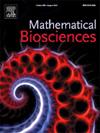心肌结构对心房颤动电图影响的分数阶建模。
IF 1.9
4区 数学
Q2 BIOLOGY
引用次数: 0
摘要
心房颤动(房颤)是最常见的心律失常,其启动和持续机制尚未完全明了。心房颤动的临床治疗程序考虑分析心房电图,其形态与心房心肌的基本结构相关。本研究采用了一个包含分数微积分的数学模型来模拟心脏电传导,并利用复值阶次来考虑组织结构的不均匀性。我们模拟了不同的波前传播模式,并使用不对称因子分析了虚拟电图。我们的结果表明,在健康和房颤条件下,动作电位和传播波阵面的形状都可以通过分数阶进行调节。此外,不对称因子会随着分数阶的变化而变化。对于心房颤动条件下的给定传播模式,可通过对分数阶形成不同配置的模拟集来生成不对称因子的变化区间,这些模拟集代表了具有不同结构异质性的心房组织样本。这种方法成功地再现了房颤患者的电图负偏转优势,而标准整数阶模型却无法预测这种优势。我们的分数阶传导模型符合临床房颤中观察到的心房结构对电动态的影响。因此,它是研究心脏电生理学的重要工具,在一个统一的模型中包含了组织的电学和结构相互作用。本文章由计算机程序翻译,如有差异,请以英文原文为准。
Fractional-order modeling of myocardium structure effects on atrial fibrillation electrograms
Atrial fibrillation (AF) is the most common cardiac arrhythmia with mechanisms of initiation and sustaining that are not fully understood. The clinical procedure for AF contemplates the analysis of the atrial electrograms, whose morphology has been correlated with the underlying structure of the atrial myocardium. This study employs a mathematical model incorporating fractional calculus to simulate cardiac electrical conduction, accounting for tissue structural inhomogeneities using complex-valued orders. Simulations of different wavefront propagation patterns were performed, and virtual electrograms were analyzed using an asymmetry factor. Our results evinced that the shapes of the action potential and the propagating wavefront can be modulated through the fractional order under both healthy and AF conditions. Moreover, the asymmetry factor changes with variations in the fractional order. For a given propagation pattern under AF conditions, variation intervals for the asymmetry factor can be generated by forming sets of simulations with different configurations for the fractional order, representing diverse samples of atrial tissue with varying degrees of structural heterogeneity. This approach successfully reproduces the electrogram negative deflection predominance seen in AF patients, which standard integer-order models cannot predict. Our fractional-order conduction model aligns with the effects of atrial structure on the electrical dynamics observed in clinical AF. Therefore, it offers a valuable tool for studying cardiac electrophysiology, encompassing both electrical and structural interactions of the tissue within a unified model.
求助全文
通过发布文献求助,成功后即可免费获取论文全文。
去求助
来源期刊

Mathematical Biosciences
生物-生物学
CiteScore
7.50
自引率
2.30%
发文量
67
审稿时长
18 days
期刊介绍:
Mathematical Biosciences publishes work providing new concepts or new understanding of biological systems using mathematical models, or methodological articles likely to find application to multiple biological systems. Papers are expected to present a major research finding of broad significance for the biological sciences, or mathematical biology. Mathematical Biosciences welcomes original research articles, letters, reviews and perspectives.
 求助内容:
求助内容: 应助结果提醒方式:
应助结果提醒方式:


